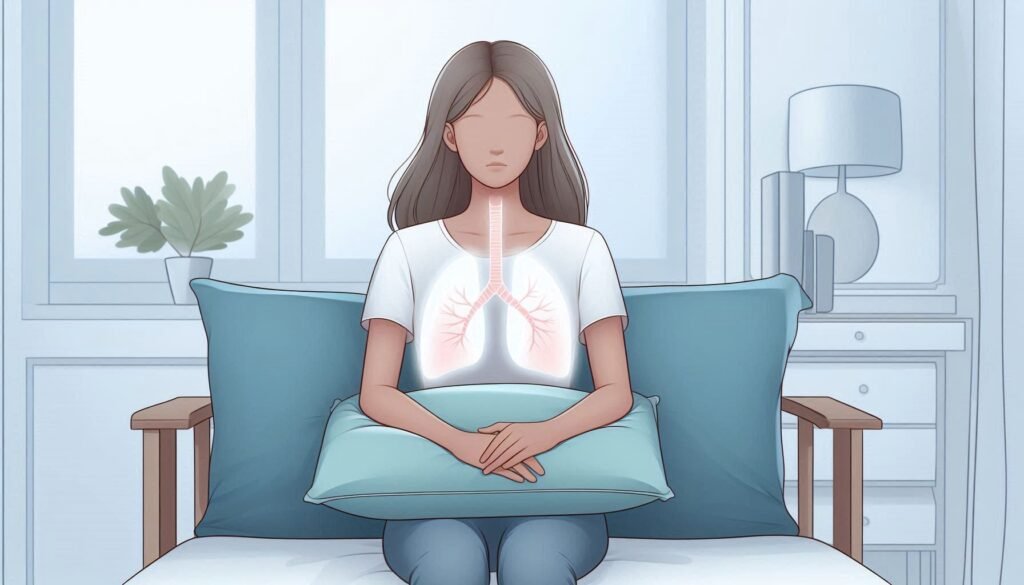Breathing is something most of us take for granted. However, for those with idiopathic pulmonary ossification (IPO), the simple act of inhaling can become a daunting challenge. Imagine your lungs gradually turning to bone, leading to increasing breathlessness and discomfort. This rare condition may not be well-known, but its impacts on quality of life are profound.
Dyspnea in idiopathic pulmonary ossification can range from mild discomfort to severe respiratory distress. It presents unique diagnostic challenges and calls for specialized management strategies that prioritize patient comfort and support. As research continues into this poorly understood condition, understanding IPO becomes vital—not only for patients but also for caregivers seeking effective ways to help their loved ones cope.
Join us as we explore the intricacies of IPO, shedding light on symptoms, treatment options, coping mechanisms, and resources available for those affected by this challenging disease.

What is idiopathic pulmonary ossification (IPO): A rare cause of breathing difficulty
Idiopathic pulmonary ossification (IPO) is an uncommon condition characterized by the abnormal formation of bone within lung tissue. This rare phenomenon leads to a progressive stiffening of the lungs, which can significantly impair respiratory function. Unlike other pulmonary disorders, IPO lacks a clear cause or identifiable risk factors, hence its designation as “idiopathic.”
The presence of bone in lung structures disrupts the normal elasticity and flexibility required for effective breathing. As a result, individuals may experience varying degrees of dyspnea—ranging from mild shortness of breath during exertion to severe respiratory distress even at rest.
Diagnosing IPO poses significant challenges due to its rarity and similarity to other conditions that affect lung function. Often, it requires advanced imaging techniques like high-resolution computed tomography (HRCT) scans or surgical lung biopsies for accurate identification.
Understanding IPO is essential because it highlights the complexity behind seemingly straightforward symptoms like breathlessness. Awareness can lead to earlier interventions and better management strategies tailored for affected individuals.
From mild discomfort to severe breathlessness: The progression of IPO symptoms
Idiopathic pulmonary ossification (IPO) often begins insidiously, with patients experiencing mild discomfort or a sensation of tightness in the chest. This early stage may be easily overlooked, mistaken for common respiratory issues like allergies or fatigue.
As IPO progresses, symptoms can intensify significantly. Patients often report increasing shortness of breath during physical activities that were previously manageable. The simple act of climbing stairs or walking might become daunting as lung function deteriorates gradually.
Over time, even resting can provoke dyspnea in many individuals with IPO. Breathlessness becomes more pronounced and persistent, affecting daily life and overall well-being. Sleep disturbances can also occur due to difficulty breathing at night.
The variability in symptom severity complicates diagnosis and management strategies further. Each patient may experience a unique trajectory of symptoms influenced by their individual health status and response to the condition’s progression. Understanding this evolution is crucial for proactive care approaches tailored to each person’s needs.
Diagnostic challenges: Identifying bone formation in lung tissue
Diagnosing idiopathic pulmonary ossification (IPO) presents unique challenges for healthcare providers. The rarity of this condition often leads to a delay in recognition, as many physicians may not immediately consider it when evaluating patients with respiratory issues.
Identifying bone formation within lung tissue requires advanced imaging techniques. Standard chest X-rays might show abnormalities but can miss early signs of ossification. High-resolution computed tomography (HRCT) scans are more effective, revealing intricate details that highlight the presence of abnormal calcifications.
Histological examination remains crucial for definitive diagnosis. A lung biopsy can confirm the abnormal growths in tissue samples, but this procedure carries its own risks and is not always feasible due to a patient’s health status.
The overlap of IPO symptoms with other pulmonary disorders complicates matters further. Misdiagnosis can lead to inappropriate treatments and worsening symptoms, underscoring the need for heightened awareness among clinicians regarding dyspnea in idiopathic pulmonary ossification.
Treatment approaches: Managing dyspnea when there’s no cure
Managing dyspnea in idiopathic pulmonary ossification (IPO) can be challenging, especially since there is currently no cure for this rare condition. The focus of treatment often shifts to alleviating symptoms and improving the quality of life for affected individuals.
Bronchodilators are commonly prescribed to help open airways, making it easier to breathe. These medications may provide some relief from breathlessness by reducing airway constriction. Corticosteroids might also be utilized to decrease inflammation in lung tissue, potentially easing discomfort.
Pulmonary rehabilitation plays a vital role as well. This structured program includes exercise training, education, and support tailored specifically for those with respiratory issues. It helps patients build endurance and learn effective breathing techniques.
Oxygen therapy may offer significant benefits when blood oxygen levels drop due to compromised lung function. By ensuring adequate oxygen delivery, patients can experience improved comfort during daily activities despite their ongoing struggles with dyspnea caused by IPO.
The role of supportive therapies in easing IPO-related breathlessness
Supportive therapies play a crucial role in managing dyspnea in idiopathic pulmonary ossification (IPO). These treatments focus on improving the patient’s quality of life, despite the absence of a cure. Healthcare providers often recommend supplemental oxygen therapy, which can alleviate shortness of breath and enhance overall comfort.
Pulmonary rehabilitation programs are another effective approach. They combine exercise training with education to help patients learn how to breathe more efficiently. This tailored support not only strengthens respiratory muscles but also offers strategies for coping with daily challenges.
Medications may also be utilized to reduce anxiety associated with breathing difficulties. Anti-anxiety drugs or bronchodilators can help ease stress during episodes of breathlessness, allowing patients to feel more at ease.
Mindfulness practices such as yoga and meditation have shown promise in alleviating symptoms related to IPO. By promoting relaxation and mental well-being, these techniques empower individuals to better manage their condition over time.
Living with IPO: Strategies for coping with progressive lung stiffening
Living with idiopathic pulmonary ossification can be challenging, especially as lung stiffness progresses. Staying informed about the condition is crucial. Knowledge empowers patients to make better decisions regarding their health and treatment options.
Creating a supportive environment is essential. Engaging family members and friends in discussions about IPO fosters understanding and empathy. This network can provide emotional support during difficult times.
Incorporating gentle exercise into your routine may help improve lung function and overall well-being. Activities like yoga or tai chi promote breath control while encouraging relaxation, making daily life more manageable.
Adopting stress-relief techniques such as meditation or mindfulness practices can also ease anxiety related to breathing difficulties. These strategies help individuals focus on their breath, promoting a sense of calm amid lung-related challenges.
Complications of IPO: When breathing becomes a daily struggle
Complications of idiopathic pulmonary ossification (IPO) can significantly affect daily life. As the condition progresses, lung tissue hardens due to abnormal bone formation, leading to increasing stiffness. This rigidity hampers normal respiratory function and elevates the severity of dyspnea.
Patients may experience recurrent respiratory infections as lung efficiency declines. Reduced airflow creates an environment ripe for pathogens, complicating treatment efforts. Frequent hospital visits become a reality for many individuals grappling with these persistent health challenges.
In addition to physical symptoms, emotional struggles often accompany IPO-related complications. Anxiety and depression may arise from chronic breathlessness, affecting overall well-being and quality of life. Managing stress becomes crucial in navigating this complex journey.
As breathing difficulties worsen over time, patients might have trouble performing everyday tasks like climbing stairs or even walking short distances. These limitations can lead to isolation and decreased social interaction as activities become more challenging.
Prognosis and monitoring: What to expect with idiopathic pulmonary ossification
The prognosis for individuals with idiopathic pulmonary ossification (IPO) varies significantly from person to person. Some may experience a slow progression of symptoms, while others face rapid deterioration in lung function. Factors influencing outcomes include age, overall health, and the extent of lung involvement at diagnosis.
Monitoring is crucial for managing IPO effectively. Regular follow-up appointments with healthcare providers can help track changes in respiratory function and symptom severity. Pulmonary function tests and imaging studies are essential tools that aid in assessing disease progression over time.
Patients often benefit from discussions about their treatment plan during these visits. Adjustments to medications or therapies can be made based on individual needs and response to existing treatments.
Lifestyle modifications also play an important role in managing the condition. Staying active within one’s limits and avoiding respiratory irritants contribute positively towards maintaining quality of life amid ongoing challenges related to dyspnea in idiopathic pulmonary ossification.
Research frontiers: Seeking answers for a poorly understood condition
Research into idiopathic pulmonary ossification (IPO) is still in its infancy. As a rare condition, it has garnered limited attention compared to more common respiratory diseases. This lack of understanding presents challenges for both patients and healthcare providers.
Scientists are beginning to explore the underlying mechanisms that lead to bone formation in lung tissue. Genetic studies may provide clues about predispositions. Investigating environmental factors could also reveal triggers that initiate this unusual process.
Clinical trials are crucial for developing new diagnostic methods and treatments. Innovative imaging techniques might help identify IPO earlier, allowing for timely intervention. Additionally, researchers are studying potential therapies aimed at reversing or halting the progression of lung stiffness.
Patient registries can enhance data collection on IPO cases worldwide. Collecting information from diverse populations will improve our understanding of this complex disease and pave the way for future breakthroughs in management strategies and supportive care.
Supporting IPO patients: Resources and tips for caregivers
Supporting individuals with idiopathic pulmonary ossification (IPO) requires a multifaceted approach. Caregivers play a crucial role in enhancing the quality of life for these patients. Understanding IPO and its impact on daily activities is vital.
Education about the condition helps caregivers anticipate challenges and provide appropriate support. Joining support groups, both online and offline, can offer invaluable advice from those who share similar experiences.
Encouraging open communication between patients and healthcare providers ensures that symptoms are effectively managed. This dialogue can also help caregivers understand treatment options available to alleviate dyspnea.
Establishing a routine that incorporates gentle exercise, breathing techniques, and relaxation methods can be beneficial, promoting better lung function despite progressive stiffness. Additionally, maintaining an organized medication schedule may prevent unnecessary complications related to treatment adherence.
Self-care should not be overlooked for caregivers themselves. Taking breaks when needed will help them remain energized and emotionally stable while supporting their loved ones through this challenging journey. Sharing resources like local health services or educational materials can empower both patients and their families as they navigate life with IPO together.


